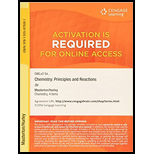
Interpretation:
The value of pH needs to be calculated if voltage is
Concept introduction:
The pH is the negative logarithm of hydrogen ion concentration. Therefore,
Nernst equation is written as follows:
Here, R represents gas constant, T represents temperature, n represents number of electron, F represents Faraday’s constant,
Answer to Problem 62QAP
At voltage
Explanation of Solution
Balance the reaction as follows:
Consider
Reduction:
Oxidation:
Atom balance as follows:
One nitrogen each side.
Hence, no adjustment is required.
Total oxidation number-
Add electrons: Oxidation number for N goes from +5 to +2. It is reduced by 3. Add three electrons to reactant side.
Balance charge: reactants
Products: 0, in acidic medium add
Balance hydrogen atom:
Reactant contains 4 H and product contains 0 H. To balance add
Balance reaction is as follows:
Atom balance as follows:
One sulphur each side. Hence, no adjustment is required.
Total oxidation number-
Add electrons: Oxidation number for S increases from +4 to +6. It is increased by 2. Add two electrons to product side.
Balance charge: Products
In acidic medium add
Balance hydrogen atom:
Reactant contains 0 H and product contains 4 H. To balance, add
Balance reaction is as follows:
Multiply equation (1) by 2 and equation (2) by 3 and add the resulting equation.
Calculate
Use Nernst equation to calculate reaction quotient ( Q) as follows:
Nernst equation is given below.
Here, R represents gas constant, T represents temperature, n represents number of electron, F represents Faraday’s constant,
Here,
Calculate concentration of
Given, pressure of all gases is
Calculate pH as follows:
Therefore, at voltage
Want to see more full solutions like this?
Chapter 21 Solutions
Owlv2, 4 Terms (24 Months) Printed Access Card For Masterton/hurley's Chemistry: Principles And Reactions, 8th
- Consider the reduction of nitrate ion in acidic solution to nitrogen oxide (Ered=0.964V) by sulfur dioxide that is oxidized to sulfate ion (Ered=0.155V) . Calculate the voltage of a cell involving this reaction in which all the gases have pressures of 1.00 atm, all the ionic species (except H+) are at 0.100 M, and the pH is 4.30.arrow_forwardAn active (metal) electrode was found to lose mass as the oxidation-reduction reaction was allowed to proceed. Was the electrode part of the anode or cathode? Explain.arrow_forwardCalculate the voltages of the following cells at 25°C and under the following conditions: (a) Zn|Zn2+(0.50M)Cd2+(0.020M)|Cd (b) Cu|Cu2+(0.0010M)H+(0.010M)|H2(1.00atm)|Ptarrow_forward
- Calculate the voltages of the following cells at 25°C and under the following conditions: (a) Cu|Cu+(0.80M)Hg22+(0.10M)|Hg|Pt (b) Cr|Cr3+(0.615M)Ni2+(0.228M)|Niarrow_forwardAn aqueous solution of an unknown salt of gold is electrolyzed by a current of 2.75 amps for 3.39 hours. The electroplating is carried out with an efficiency of 93.0%, resulting in a deposit of 21.221 g of gold. a How many faradays are required to deposit the gold? b What is the charge on the gold ions (based on your calculations)?arrow_forwardAn aqueous solution of an unknown salt of vanadium is electrolyzed by a current of 2.50 amps for 1.90 hours. The electroplating is carried out with an efficiency of 95.0%, resulting in a deposit of 2.850 g of vanadium. a How many faradays are required to deposit the vanadium? b What is the charge on the vanadium ions (based on your calculations)?arrow_forward
- In the electrolysis of a solution containing Ag+(aq), metallic Ag(s) deposits on the cathode. Using a current of 1.12 A for 2.40 hours, what mass of silver forms?arrow_forwardIf alkaline batteries were not alkaline but rather acidic (as in the older dry cell batteries), what extra difficulties could you envision with corrosion, based on reactions that are part of the table of standard reduction potentials?arrow_forwardChlorine, Cl2, is produced commercially by the electrolysis of aqueous sodium chloride. The anode reaction is 2Cl(aq)Cl2(g)+2e How long will it take to produce 2.00 kg of chlorine if the current is 5.00 102 A?arrow_forward
- A factory wants to produce 1.00 103 kg barium from the electrolysis of molten barium chloride. What current must be applied for 4.00 h to accomplish this?arrow_forwardA metallurgist wants to gold-plate an object with a surface area of 17.21 in2. The gold plating must be 0.00200 in. thick (assume uniform thickness). (a) How many grams of gold (d=10.5g/cm3) are required? (b) How many minutes will it take to plate the object from a solution of AuCN using a current of 7.00 A? Assume 100% efficiency.arrow_forward
 Chemistry: Principles and ReactionsChemistryISBN:9781305079373Author:William L. Masterton, Cecile N. HurleyPublisher:Cengage Learning
Chemistry: Principles and ReactionsChemistryISBN:9781305079373Author:William L. Masterton, Cecile N. HurleyPublisher:Cengage Learning Chemistry by OpenStax (2015-05-04)ChemistryISBN:9781938168390Author:Klaus Theopold, Richard H Langley, Paul Flowers, William R. Robinson, Mark BlaserPublisher:OpenStax
Chemistry by OpenStax (2015-05-04)ChemistryISBN:9781938168390Author:Klaus Theopold, Richard H Langley, Paul Flowers, William R. Robinson, Mark BlaserPublisher:OpenStax ChemistryChemistryISBN:9781305957404Author:Steven S. Zumdahl, Susan A. Zumdahl, Donald J. DeCostePublisher:Cengage Learning
ChemistryChemistryISBN:9781305957404Author:Steven S. Zumdahl, Susan A. Zumdahl, Donald J. DeCostePublisher:Cengage Learning Chemistry: An Atoms First ApproachChemistryISBN:9781305079243Author:Steven S. Zumdahl, Susan A. ZumdahlPublisher:Cengage Learning
Chemistry: An Atoms First ApproachChemistryISBN:9781305079243Author:Steven S. Zumdahl, Susan A. ZumdahlPublisher:Cengage Learning
 General Chemistry - Standalone book (MindTap Cour...ChemistryISBN:9781305580343Author:Steven D. Gammon, Ebbing, Darrell Ebbing, Steven D., Darrell; Gammon, Darrell Ebbing; Steven D. Gammon, Darrell D.; Gammon, Ebbing; Steven D. Gammon; DarrellPublisher:Cengage Learning
General Chemistry - Standalone book (MindTap Cour...ChemistryISBN:9781305580343Author:Steven D. Gammon, Ebbing, Darrell Ebbing, Steven D., Darrell; Gammon, Darrell Ebbing; Steven D. Gammon, Darrell D.; Gammon, Ebbing; Steven D. Gammon; DarrellPublisher:Cengage Learning





